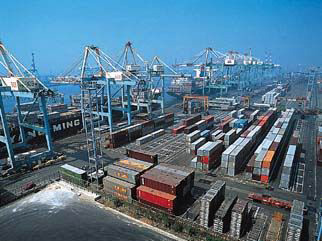 On November 22, He Jianzhong, member of the Party Group, Department of Policy and Regulations, and spokesman of the Ministry of Transport, said at a regular press conference that the signs of stabilizing the transportation economy are evident and generally stable. It is expected that the two months after this year will continue. Maintaining a moderate upward trend, the scale of fixed asset investment in the whole year is expected to remain basically the same as that of the previous year.
On November 22, He Jianzhong, member of the Party Group, Department of Policy and Regulations, and spokesman of the Ministry of Transport, said at a regular press conference that the signs of stabilizing the transportation economy are evident and generally stable. It is expected that the two months after this year will continue. Maintaining a moderate upward trend, the scale of fixed asset investment in the whole year is expected to remain basically the same as that of the previous year. He Jianzhong said that with the national macroeconomic stabilization and recovery effect, September and October, the transportation economy has shown a sustained upward trend. The first three quarters of fixed asset investment growth rate were -7.7%, -5.4% and 2.5%, the third quarter to achieve positive growth, especially in October, the growth rate compared with September growth of 3.3 percentage points, an increase of 21.3 percentage points over the same period last year .
The main indicators for transportation production maintained growth from January to October, accumulatively completing 1.1343 trillion yuan in fixed-water investment in highway and water transportation, down 0.5% year-on-year. The growth rate was 12 percentage points lower than that of the same period of last year, and the scale of fixed asset investment declined slightly, but the rate of decline decreased. Gradually narrowed, the investment structure was further optimized. Among them, the investment in highway construction was 997.4 billion yuan, a year-on-year decrease of 1.0%, and the growth rate was 10.9 percentage points lower than the same period of last year; the investment in completion of inland river construction was 36.8 billion yuan, a year-on-year increase of 26.7%, and the growth rate was 1.9 percentage points lower than the same period of last year; The completed investment was 81 billion yuan, a year-on-year decrease of 0.4%, and the growth rate was 32.8 percentage points lower than the same period of last year.
According to statistics, from January to October this year, the main indicators for transport and production continued to grow, and the growth rate slowed down. From January to October, the total volume of cargo handled by ports above designated size totaled 8.06 billion tons, a year-on-year increase of 6.7%, and the growth rate was 7.1 percentage points lower than that of the same period of last year. Among them, the completion of foreign trade cargo throughput was 2.51 billion tons, an increase of 9.9%; domestic trade cargo throughput was 5.55 billion tons, an increase of 5.2%. From January to October, the container throughput of the port was 146.10 million TEUs, an increase of 8.1% year-on-year, a decrease of 4.6 percentage points from the same period of last year. The low container throughput this year was in July and August, with a growth rate of 5%. In September, the growth rate exceeded double digits. In October, it fell back to 7.8%, and the overall growth rate showed an upward trend.
Cobalt-based alloy powders are commonly used in plasma transfer arc welding (PTAW) due to their excellent high-temperature properties and resistance to wear and corrosion. These alloys are typically composed of cobalt as the base metal, with various alloying elements such as chromium, tungsten, nickel, and carbon added to enhance specific properties.
The use of cobalt-based alloy powders in PTAW offers several advantages, including:
1. High-temperature strength: Cobalt-based alloys exhibit excellent strength and resistance to deformation at elevated temperatures, making them suitable for welding applications that involve high heat.
2. Wear resistance: These alloys have a high hardness and resistance to wear, making them ideal for welding applications where the welded parts are subjected to abrasive or erosive conditions.
3. Corrosion resistance: Cobalt-based alloys offer good resistance to corrosion, making them suitable for welding applications in aggressive environments, such as those involving chemicals or saltwater.
4. Thermal conductivity: Cobalt-based alloys have good thermal conductivity, allowing for efficient heat transfer during welding and reducing the risk of heat-affected zone (HAZ) defects.
5. Compatibility with other materials: Cobalt-based alloys can be easily welded to a wide range of base metals, including stainless steels, nickel alloys, and other cobalt-based alloys, providing versatility in welding applications.
To use cobalt-based alloy powders for PTAW, the powder is typically fed into the plasma arc using a powder feeder. The powder is then melted by the high-temperature plasma arc and deposited onto the workpiece, forming a weld bead. The specific welding parameters, such as arc current, travel speed, and powder feed rate, will depend on the specific alloy and application requirements.
It is important to note that the selection of the cobalt-based alloy powder should be based on the specific welding application and the desired properties of the final weld. Different cobalt-based a
Co Powder,Cobalt 6 Powder,Cobalt 12 Powder,Cobalt 21 Powder
Luoyang Golden Egret Geotools Co., Ltd , https://www.xtclasercladding.com